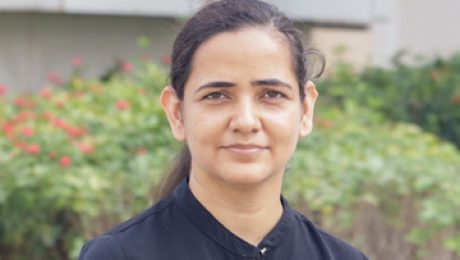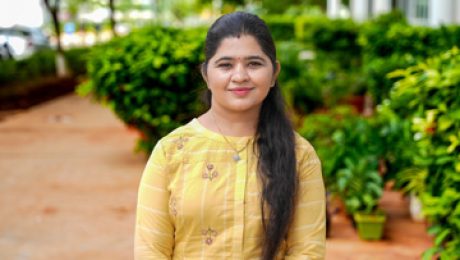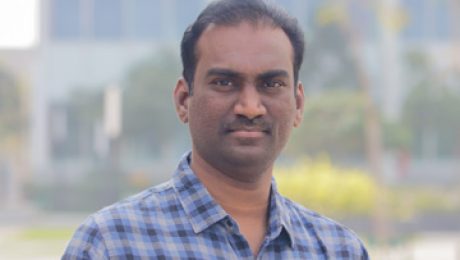Dr Uma Maheswar Arepalli
- Published in CE Faculty, Faculty, SEAS
Resonating Ideology: Dr Ram Kulesh Thakur re-evaluating Bose in the present era
 Netaji Subhas Chandra Bose is nationwide revered as a legendary figure of the Indian National Movement. A study of his biography unfolds his unflagging zeal, as a leader and motivator. His social, economic, and political concepts were formulated with the sole objective of India’s emancipation from the British rule of exploitation and oppression. He also thought about the reconstruction of Free India.
Netaji Subhas Chandra Bose is nationwide revered as a legendary figure of the Indian National Movement. A study of his biography unfolds his unflagging zeal, as a leader and motivator. His social, economic, and political concepts were formulated with the sole objective of India’s emancipation from the British rule of exploitation and oppression. He also thought about the reconstruction of Free India.
According to Subhas Chandra Bose, education was essential for character building and overall development of human life. Education unveils the internal discipline of mind and thoughts, which in its turn produces external discipline of control of action or deeds.
He understood the need for female education and female emancipation- liberating from all shackles and artificial disabilities – social, economic and political. Netaji Subhas Chandra was completely against of any discrimination on the grounds of caste, race, sex, creed or wealth in Free India.
His addresses at the Indian National Congress bears Subhas Chandra’s ideas on a comprehensive reconstruction of Free India. Bose wanted the states to adopt an elaborate scheme for gradually socialising the entire agricultural and industrial system in the spheres of both production and distribution. He also advocated the abolition of landlordism and liquidation of agricultural indebtedness. According to Netaji, liberty broadly signified political, economic and social freedom. For him, economic freedom was the essence of social and political freedom.
However, if we look at today’s India and the happenings, can we claim for sure that we have imbibed the great leader’s vision in its true essence? We are free constitutionally, but are we really free at all? Is this the freedom our great freedom fighters like Bose envisioned for us?
Department of Student Affairs is organising a webinar on the birthday of Netaji Subhas Chandra Bose to honour and recall his beliefs on freedom and Nation. Dr Ram Kulesh Thakur will be talking on “Am I Free? Re-Contextualising Subhas Chandra Bose in the Present Era.” Dr Thakur is an Assistant Professor in the Department of English. Join the webinar on January 23 at 5 pm with Dr Ram Kulesh Thakur, who will be shedding some light on this much-debated topic.
- Published in Events, Students Affairs Events
Innovation Cell presents Smart Idea Contest – Fortune always favours the BRAVE!
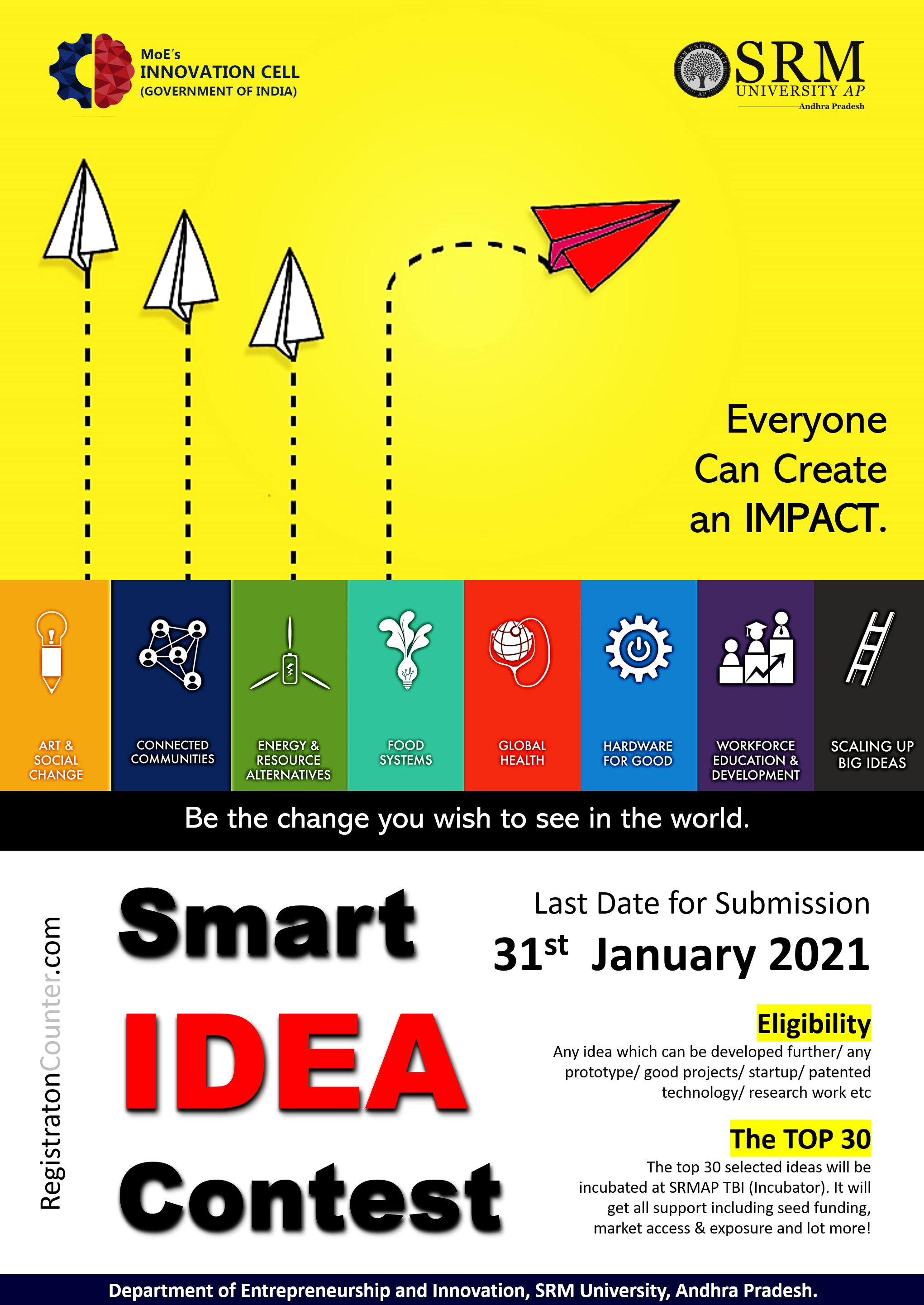 The innovation cell of SRM University-AP, Andhra Pradesh has arranged the Smart Idea contest on January 31, 2020. Ideated by Mr Udayan Bakshi, Associate Director, Department of Innovation and Entrepreneurship, the contest aims at ushering individuals to envisage a better world through innovative ideas, concepts, and aspirations. During this competition, the participants would be presenting their impactful concept, prototype, project, research, and business idea, to unravel problems of the society.
The innovation cell of SRM University-AP, Andhra Pradesh has arranged the Smart Idea contest on January 31, 2020. Ideated by Mr Udayan Bakshi, Associate Director, Department of Innovation and Entrepreneurship, the contest aims at ushering individuals to envisage a better world through innovative ideas, concepts, and aspirations. During this competition, the participants would be presenting their impactful concept, prototype, project, research, and business idea, to unravel problems of the society.
The essence of life encompasses ambitions, and the determination to make a difference to the society. Participating in the contest will enable students, faculty, staff, alumni, PhD scholars to brave an idea and enhance their visibility. Apart from being mentored by the industry experts, the pacesetters will receive seed funding, venture capital funding, and additional support to shape and scale up their businesses. Unconventional visionaries inclined to augment the purpose of life are urged to participate in the contest to establish a better world.
Registration Link: Click Here
- Published in Events, IDEA Events
Enriching pedagogy
SRM AP signs MoU with Flinders University to propagate quality education and research
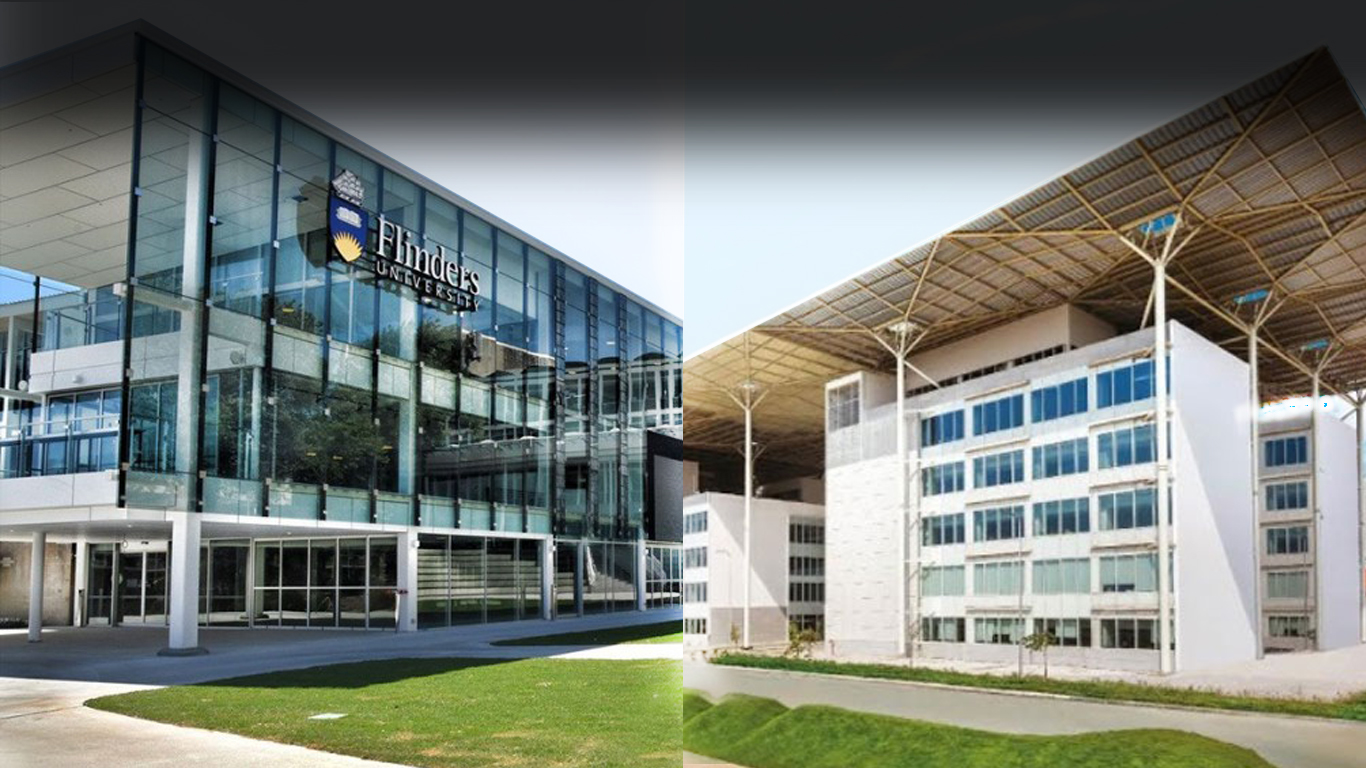 SRM University AP, Andhra Pradesh announces the signing of Memorandum of Understanding (MoU) with Flinders University, Australia to foster knowledge creation, skill enhancement, and advancement of industry association. Flinders University, established in 1966, has over 25,000 students and over 2,500 academic and professional staff who promotes an incredible teaching and research ethos. These two universities of global repute purposes to share knowledge, competencies, expertise, and industry partners for their reciprocal benefit. The establishment of a framework for collaboration will enable the enrichment of pedagogy and research to support the propagation of quality education and scientific pursuits.
SRM University AP, Andhra Pradesh announces the signing of Memorandum of Understanding (MoU) with Flinders University, Australia to foster knowledge creation, skill enhancement, and advancement of industry association. Flinders University, established in 1966, has over 25,000 students and over 2,500 academic and professional staff who promotes an incredible teaching and research ethos. These two universities of global repute purposes to share knowledge, competencies, expertise, and industry partners for their reciprocal benefit. The establishment of a framework for collaboration will enable the enrichment of pedagogy and research to support the propagation of quality education and scientific pursuits.
Exchange of students and participation in student mobility schemes, exchange of faculty members, joint research activities and training, exchange of materials, information and publications, and cooperation in common academic fields are the key driving influences enhancing the collaboration between SRM AP and Flinders University. The alliance is believed to commence opportunities for the students and faculty of SRM AP pertaining to visits, internships, and research collaboration.
- Published in Collaborations, News
Innovation Cell empowers SRM AP teams to emerge glorious in Toycathon-2021
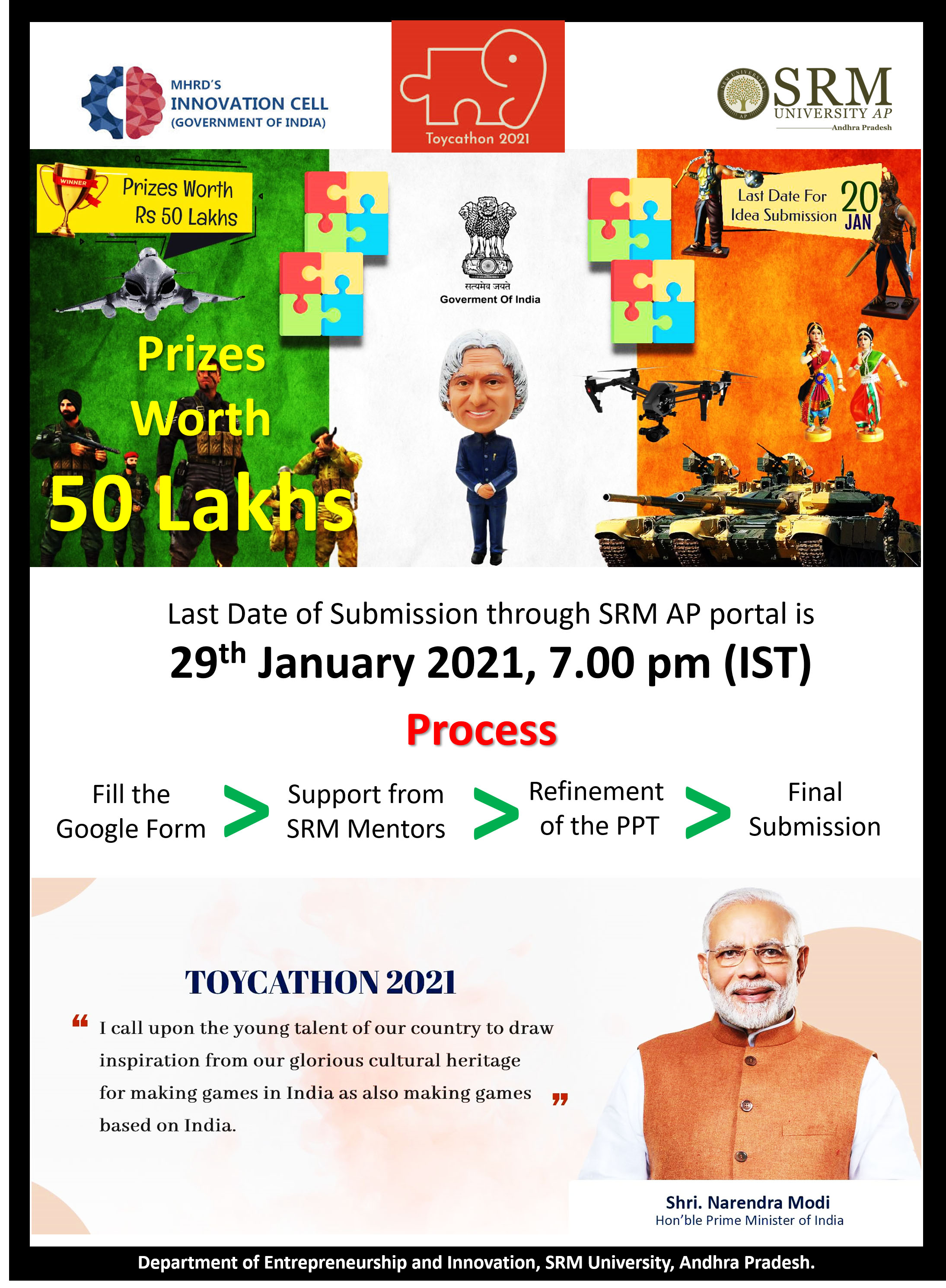 The smart minds of SRM University-AP, Andhra Pradesh receives an opportunity to present their creative skills in the Toycathon-2021. Organized by the Ministry of Education’s Innovation Cell, Toycathon- 2021 challenges India’s contemporary minds to conceptualize Toy and Games inspired by Indian civilization, history, culture, mythology, and ethos. This unique opportunity will also enable exceptional innovators to win prizes worth Rs. 50 lakhs. In addition, the winning team’s efforts will be commercialized with support from the industry and investors.
The smart minds of SRM University-AP, Andhra Pradesh receives an opportunity to present their creative skills in the Toycathon-2021. Organized by the Ministry of Education’s Innovation Cell, Toycathon- 2021 challenges India’s contemporary minds to conceptualize Toy and Games inspired by Indian civilization, history, culture, mythology, and ethos. This unique opportunity will also enable exceptional innovators to win prizes worth Rs. 50 lakhs. In addition, the winning team’s efforts will be commercialized with support from the industry and investors.
The Department of Innovation and Entrepreneurship, SRM University AP has developed a panel of experts who will validate the presentation of the groups eager to participate in the contest. Further, assistance will be provided to the groups at every stage of the competition including support in preparing an enthralling pitch. This will empower the teams to have an edge while representing SRM AP in the national forum.
Last Date of Submission: January 29, 2021, at 7 PM
Registration Link: Click Here
- Published in Events, IDEA Events
National Voters’ Day
Awareness Programme at SRM University-AP to ensure participation in the electoral process
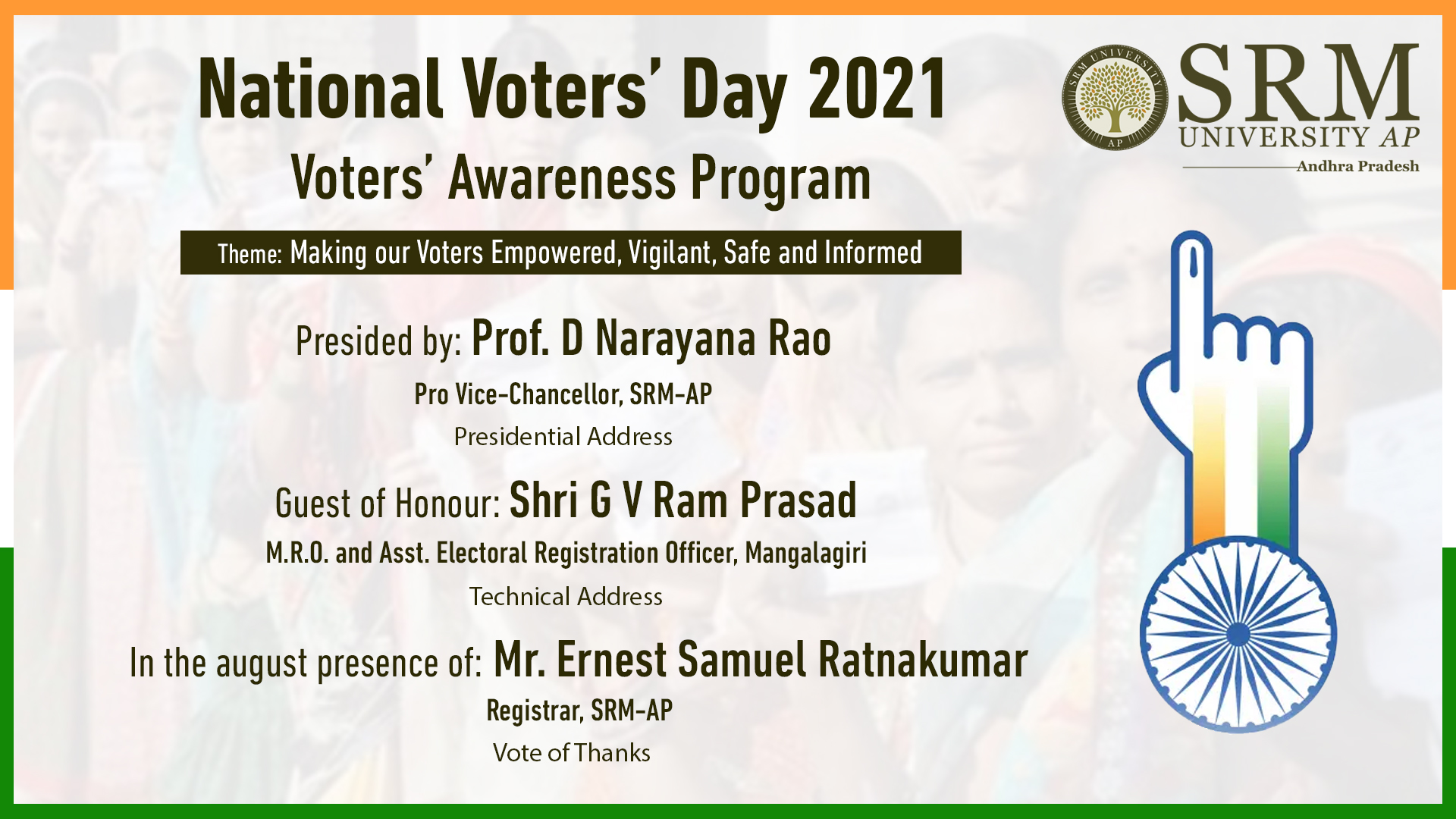 SRM University-AP organised a Voter Awareness Programme on National Voters’ Day to inspire voters to enhance their participation in the electoral process. National Voters’ Day is observed every year on January 25 to spread awareness among the voters. Guest of Honour, Shri G V Ram Prasad, M.R.O. and Assistant Electoral Registration Officer-Mangalagiri explained why it is crucial for people in a democracy like India to take part in the Electoral Process. Prof D Narayana Rao, Pro-Vice-Chancellor, Mr Ernest Samuel Ratnakumar, Registrar attended the event along with the faculty and staffs of SRM University- AP.
SRM University-AP organised a Voter Awareness Programme on National Voters’ Day to inspire voters to enhance their participation in the electoral process. National Voters’ Day is observed every year on January 25 to spread awareness among the voters. Guest of Honour, Shri G V Ram Prasad, M.R.O. and Assistant Electoral Registration Officer-Mangalagiri explained why it is crucial for people in a democracy like India to take part in the Electoral Process. Prof D Narayana Rao, Pro-Vice-Chancellor, Mr Ernest Samuel Ratnakumar, Registrar attended the event along with the faculty and staffs of SRM University- AP.
In his presidential address, Prof D N Rao explained why we have this need to celebrate National Voters’ Day. The main objective of the Voters’ Day is to ensure the facilitation of new voters and encourage their participation into casting votes. To understand this power of Democracy, one must be aware of this nation’s history. The journey from Monarchy to Democracy was arduous. In previous days, to change one’s king or leader, the people have to go through a violent process such as revolt or execution of the king. Now the process is much easier. One only needs to cast his vote to the person he prefers. In this way, only those who are chosen by the people of the country will be elected to run the nation. Therefore, it is essential to cast one’s vote. Votes are the voices of people in a democracy. In the absence of votes, the nation might not get the leaders it needs.
Shri Ram Prasad further added that the Voters’ Day was initiated by Mrs Pratibha Patil, former President of India, on the 61st foundation day of Election Commission. He said, “It is unfortunate to note that, in this largest Democracy of the world, only 50-60% of the votes are being cast in an average. It clearly shows that many people of this great country still unaware of the great power that Democracy provides them. The concept of celebrating Voters’ day came into being with this goal to make these people understand their power in deciding the nation’s future. He also informed that this year, the Government of India has agreed to launch e-EPIC card for voters’ benefit. e-EPIC is a portable document format(PDF) version of the EPIC which can be downloaded on mobile or in a self-printable form on the computer. A voter can thus store the card on his/her mobile, upload it on Digi locker or print it and self-laminate it. This is in addition to PCV EPIC being issued for fresh registration. Mr Earnest Samuel concluded reminding the audience that in or after 1947, several countries got their independence. But none carries a legacy as ours. It is each and every one of our duty to carry forward this legacy so that India can be Democratic in its true notion.
- Published in News
73rd Outreach Programme of IIRS-ISRO on “Overview of Geo-processing using Python”
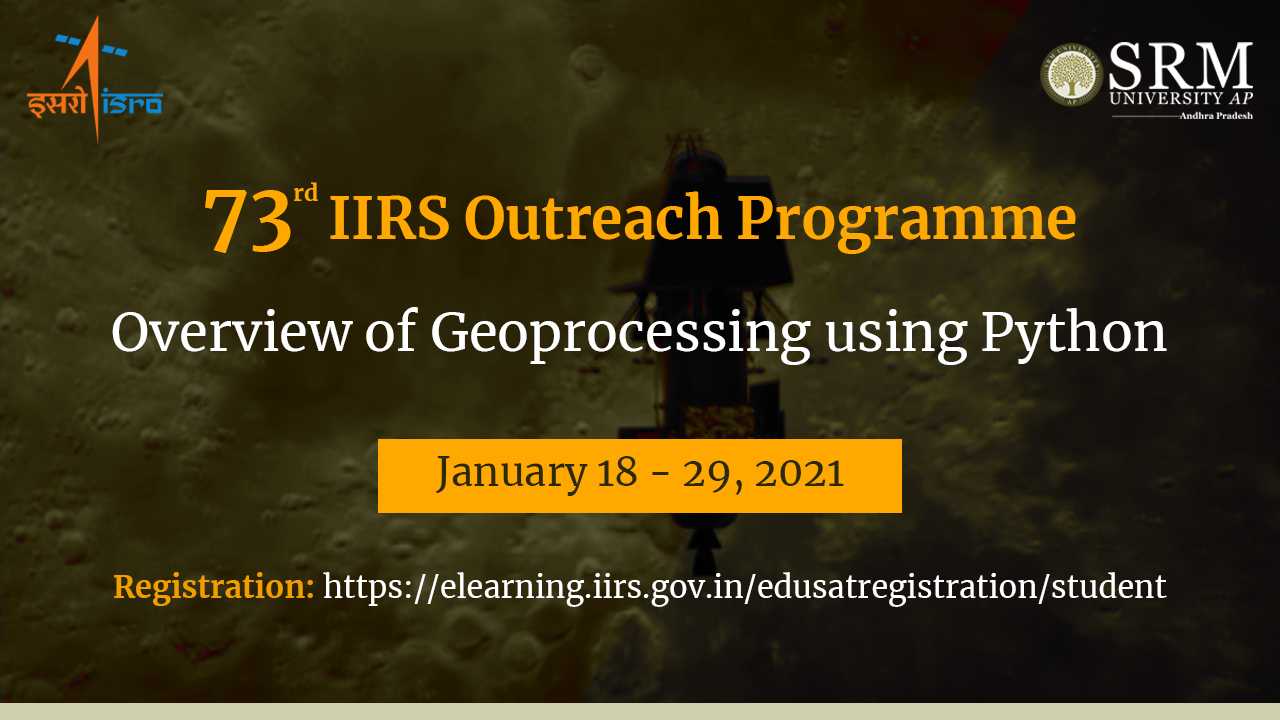 Students of SRM University AP, Andhra Pradesh get the opportunity to attend the 73rd outreach programme titled “Overview of Geo-processing using Python” arranged by Indian Institute of Remote Sensing (IIRS) -Indian Space Research Organization (ISRO). In the modern era, satellite imagery fused with the power of Geographic Information System enhances environmental management system by providing solutions pertaining to issues such as disasters, global climate change, natural resources, wildlife, and land cover. Effectively processing the massive data to decipher useful information is considered the most challenging aspect of geospatial technology. This programme encompassing a session from January 18, 2021 till January 29, 2021 will enable the participants to use Python to visualize geospatial data and derive the desired knowledge, mitigating the aforementioned challenge. Students of SRM AP are encouraged to attend this programme to broaden the prospect of achieving their career aspirations.
Students of SRM University AP, Andhra Pradesh get the opportunity to attend the 73rd outreach programme titled “Overview of Geo-processing using Python” arranged by Indian Institute of Remote Sensing (IIRS) -Indian Space Research Organization (ISRO). In the modern era, satellite imagery fused with the power of Geographic Information System enhances environmental management system by providing solutions pertaining to issues such as disasters, global climate change, natural resources, wildlife, and land cover. Effectively processing the massive data to decipher useful information is considered the most challenging aspect of geospatial technology. This programme encompassing a session from January 18, 2021 till January 29, 2021 will enable the participants to use Python to visualize geospatial data and derive the desired knowledge, mitigating the aforementioned challenge. Students of SRM AP are encouraged to attend this programme to broaden the prospect of achieving their career aspirations.
Programme Schedule: Please Click Here
Registration Link: Please Click Here
For further details, Visit Here
- Published in ECE Events, Events
SRM University-AP observed 72nd Republic Day
 Republic Day is observed in SRM University-AP to commemorate the day on which the Constitution of India came into effect, in the year 1950, and the country became a republic. Like every year, this year too the faculty, staff and students of SRM University-AP gathered around to honour the day. Amidst the COVID-19 pandemic, the university celebrated Republic Day by following the safety rules and regulations. The Celebration started with a Rangoli Competition, in which our neighbours from the surrounding villages joined us. This was followed by flag hoisting ceremony and march past of the staffs. Prof D Narayana Rao, Pro-Vice-Chancellor, did the honour of hoisting the National Flag. Mr Ernest Samuel Ratnakumar, Registrar; Ms Revathi B, Assistant Director-Student Affairs, Mr Abdul Mohimin, Assistant Director-Sports were among the dignitaries.
Republic Day is observed in SRM University-AP to commemorate the day on which the Constitution of India came into effect, in the year 1950, and the country became a republic. Like every year, this year too the faculty, staff and students of SRM University-AP gathered around to honour the day. Amidst the COVID-19 pandemic, the university celebrated Republic Day by following the safety rules and regulations. The Celebration started with a Rangoli Competition, in which our neighbours from the surrounding villages joined us. This was followed by flag hoisting ceremony and march past of the staffs. Prof D Narayana Rao, Pro-Vice-Chancellor, did the honour of hoisting the National Flag. Mr Ernest Samuel Ratnakumar, Registrar; Ms Revathi B, Assistant Director-Student Affairs, Mr Abdul Mohimin, Assistant Director-Sports were among the dignitaries.
In his address, Prof Narayana Rao briefly explained India’s progress since independence in the fields of Education, Industry, Healthcare, Agriculture, Information Technology and others. At the time of independence, India was a poor country with 12% literacy rate and 35-40 years of average life expectancy. In the past 70 years, India has emerged as one of the world’s leading knowledge superpowers. Many other countries also earned independence at the same time as India’s. But only India has been able to utilise its human resources and wisdom to achieve greatness. In the following years after independence, India did not even have enough food grains to feed a country of 30 crores people. Food grains had to be imported from other countries like Myanmar. However, today, India not only is solvent enough to feed its 130-crore people but also exports food grains to other needy and poor countries. Be it agriculture, education or healthcare, India’s progress so far has been remarkable. The reputed institutes such as IITs, IISERs, NITs, IISc, ISIs, AIMs are performing beyond expectations educating the people of this country. Leading research organisations and regulatory bodies such as CSIR, ISRO, DRDO, DST, DBT are rigorously working to make this country do big and achieve big. “These organisations came into being with great vision, and we feel very proud to say that they are on par with any other organisations of the leading developed countries. COVID-19 pandemic brought an unprecedented crisis all over the world. But Indian biotech companies were able to make the COVID vaccines within a very short span of time. It is a moment of pride for every Indian that India has become the world’s vaccine factory. No other country has the capability to produce vaccines in such a large number”, asserted Prof Rao. He further added that India had progressed very much in establishing communication even in the remote villages with the help of satellites. India’s advancement in designing, developing and launching satellites is exceptional. Data connectivity and Internet are the basic needs of today’s world, and India is the country that provides such connectivity at the lowest price in the world. Over the years after independence, India has learnt to use its human resource effectively. In today’s world, India produces the most numbers of skilled professionals to meet the need of this era. Indians are scaling greater heights in every sphere. Satya Nadela, Sundar Pichai are a few examples of how Indians are taking over the world with their brilliance and intellect. This country has been politically independent for a while, and it is now the high time to be technologically independent. “We are progressing very fast, and we have the power and potential to emerge as one of the major economic powers in the coming days. With a capability to turn every crisis into an opportunity, we move forward towards an ‘Atma-Nirbhar Bharat’ following our Prime Minister’s advice of Innovate, Patent, Produce and Prosper,” said Prof Narayana Rao.
Adhering to the spirits of patriotism, Mr Raviteja Reddy, Mr A Chaitanya, Mr P M Aditya, Mr K Praveen, K Yeshashwini, A Sravya, K Vasu, G Priyanka, students of mechanical engineering, demonstrated their eco-friendly bike which was made recently by converting IC Engine bike to electric bike, under the mentorship of Dr Venkata Nori and Dr P Jayaprakash Sharma. Their successful venture was highly praised by the dignitaries present in the event.
The event concluded with the Prize Distribution Ceremony. The Winners and Participants of Rangoli Competition and Fancy-Dress Competition for Kids were congratulated by Prof D Narayana Rao, Mr Ernest Samuel Ratnakumar and Smt Priya. Prof Rao felicitated Dr Sutharsan Govindrajan, Department of Biological Sciences; Dr Mannathan, Dr Mahesh Kumar Ravva, Dr Nimai Mishra, Department of Chemistry; Dr Jatis Dash, Dr Siddhartha Ghosh, Department of Physics for their research contribution in Nature Index Ranking-2020.
- Published in News


